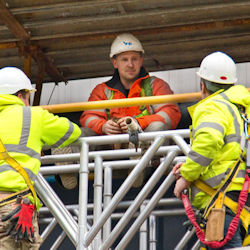How to Evaluate Fall Hazards
Determine How Frequently Workers Will Do Tasks
The more frequently a worker is exposed to a fall hazard the more likely it is that the worker could fall.
Determine If and How Workers Need to Move
Determine whether workers need to move horizontally, vertically, or in both directions to do their tasks. How workers move to perform tasks can affect their risk of falling. Knowing how they move to perform tasks can help you determine how to protect them.
Determine the Degree of Exposure
Generally, the more workers that are exposed to a fall hazard, the more likely it is one could fall.
Determine Hazardous Walking-Working Surfaces
Identify walking-working surfaces that could expose workers to fall hazards. Examples: floors, roofs, ramps, bridges, runways, formwork, beams, columns, trusses, and rebar. Actually, there is no way to make a totally hazard-free walking-working surface in the workplace: it's dangerous to assume anything different.
Knowledge Check Choose the best answer for the question.
3-5. Which statement is true regarding walking-working surfaces?
You forgot to answer the question!

